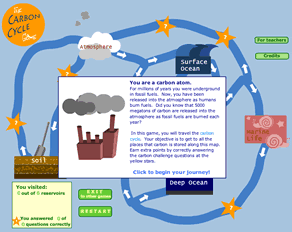Abiotic Cycles: An Introduction
Every plant, every animal, and every living organism on earth is made of materials that have been used and re-used many times. In short, we are all made of recycled parts! Just think, nitrogen atoms in the protein that makes up your hair might have come from an apple you ate weeks ago. That apple acquired nitrogen atoms from the soil the apple tree was planted in, and the nitrogen in the soil was fixed from nitrogen gas in the air.
All the chemical elements (e.g., carbon, nitrogen, oxygen) that make up living cells continuously flow between living things and the nonliving environment through abiotic cycles. The following are the most well-known abiotic cycles:
- The carbon cycle
- The nitrogen cycle
- The water cycle
- The sulfur cycle
- The phosphorus cycle
- The rock cycle
We will focus on two of these cycles— the carbon cycle and the nitrogen cycle. Let's first take a look at the carbon cycle.
The Carbon Cycle
Carbon is a major component of all known life. In fact, carbon is such an important ingredient of living tissue and the Earth's ecosystems that life on Earth is often described as "carbon-based life." The flow of carbon between the atmosphere, oceans, terrestrial ecosystems, and sediments is known as the carbon cycle.
Directions: Watch Keeping Up With Carbon for an introduction to the carbon cycle.
The Carbon Cycle: A Closer Look
Directions: Review this image that shows the components of the global carbon cycle. Click on each plus sign for information to help you understand all that is shown in the image. You can expand the image by clicking on the symbol in the upper right.
The Carbon Cycle: Review Game
Click on the image below to play the interactive Carbon Cycle Game. In this game, you will be a carbon compound moving through the carbon cycle. You can take different paths through the cycle. As you move through the carbon cycle, read the information provided as you choose a direction. Notice that you can click on words in blue for more information on a specific process. A "?" is your chance to check what you have learned.
The Nitrogen Cycle
Nitrogen is another important element to all life on earth. All organisms require nitrogen to make amino acids, which are the building blocks of proteins. About 78% of the Earth's atmosphere is made up of nitrogen gas, N2, but this form of nitrogen is not usable by most organisms. For nitrogen to be usable, it must be converted into other forms, including ammonium ions, NH4+; nitrite ions, NO2-; and nitrate ions, NO3-. The nitrogen cycle describes how nitrogen moves between these forms as it passes through plants, animals, bacteria, the atmosphere, and soil. There are several processes involved in the nitrogen cycle, including nitrogen fixation, ammonification, nitrification, assimilation, and denitrification.
Directions: Watch What is the Nitrogen Cycle? to learn about the processes involved in the nitrogen cycle.
The Nitrogen Cycle: A Closer Look
Directions: Look at this image showing the processes involved in the nitrogen cycle. Click on each plus sign for more information about each process. You can expand the image by clicking on the symbol in the upper right.
Like the carbon cycle, human activities can also influence the nitrogen cycle. One of the major influences of humans on the nitrogen cycle occurs through the use of nitrogen-containing fertilizers. Fertilizers are used by homeowners to maintain and improve lawns and gardens and by farmers to boost crop yield. Nitrogen is often the primary nutrient in fertilizers because of all the fertilizer nutrients. It produces the greatest growth response in plants. Fertilizers usually contain nitrogen in its nitrate form, which easily dissolves in water. As a result, excess nitrogen from fertilizers can easily enter groundwater and runoff into nearby streams and lakes.
Directions: Watch Eutrophication to see what can happen when excess nitrogen enters a lake through runoff.
